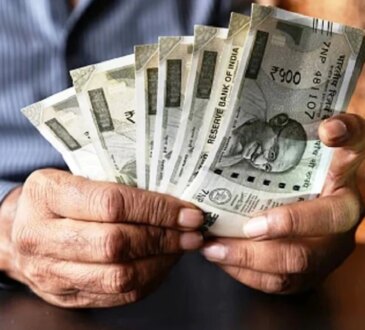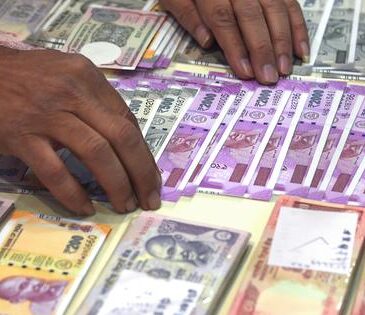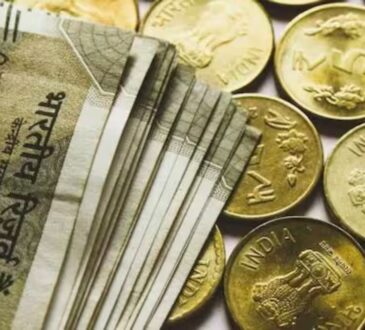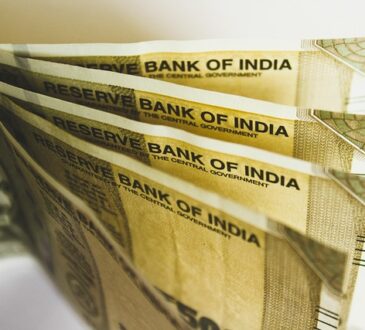- The Pound Sterling falls sharply below 1.3200 against the US Dollar after the US and China agree to reduce tariffs for 90 days by 115%.
- Lower US tariffs would pave the way for the Fed to cut interest rates.
- This week, investors will focus on the UK employment and the US CPI data on Tuesday.
The Pound Sterling (GBP) tumbles to near 1.3170 against the US Dollar (USD) and trades near a one-month low on Monday. The GBP/USD pair falls sharply as the US Dollar strengthens after the United States (US) and China agreed on a reduction in tariffs imposed in the trade war in April, which will come into effect on Wednesday, for 90 days.
The US Dollar Index (DXY), which tracks the Greenback’s value against six major currencies, surges to near 101.80, the highest level since April 10.
US Treasury Secretary Scott Bessent has announced in a scheduled briefing during European trading hours that both Washington and China have agreed to lower import duties by 115%, Reuters reported. This indicates that current levies on the US and China are 10% and 30%, respectively. Bessent stated that fentanyl issues have not been resolved yet. Therefore, tariffs on China still stand at 30%.
The impact of the US-China trade resolution is favorable for the majority of asset classes across the globe, especially the US Dollar and US assets, which were dumped heavily when the trade war between the world’s two largest economic countries stemmed after Beijing announced counter-tariffs. The Greenback came down by over 6% since US President Donald Trump announced reciprocal tariffs on the so-called Liberation Day.
Meanwhile, the resolution of the US-China trade war will also diminish elevated US consumer inflation expectations, a scenario that will pave the way for the Federal Reserve (Fed) to resume the monetary policy easing cycle, which it paused in January.
Comments from Bessent, US Trade Representative Jamieson Greer, and China’s Vice Commerce Minister Li Chenggang have signaled that both nations have made “substantial progress” in high-stakes trade talks in Geneva over the weekend.
The two-day meeting between the US and its Chinese counterparts over the weekend in Switzerland has managed to defuse the ongoing Sino-US trade war. “I’m happy to report that we’ve made substantial progress between the US and China in the very important trade talks,” Bessent said, Yahoo Finance reported.
“We’re confident that the deal we struck with our Chinese partners will help us to work toward resolving the trade deficit,” US Trade Representative Greer said. On the other hand, China’s Vice Commerce Minister Li Chenggang said it would contain “good news for the world.”
US Dollar PRICE Today
The table below shows the percentage change of US Dollar (USD) against listed major currencies today. US Dollar was the strongest against the Japanese Yen.
| USD | EUR | GBP | JPY | CAD | AUD | NZD | CHF | |
|---|---|---|---|---|---|---|---|---|
| USD | 1.00% | 0.79% | 1.02% | 0.46% | 0.04% | 0.56% | 0.96% | |
| EUR | -1.00% | -0.08% | 0.54% | -0.05% | -0.32% | 0.05% | 0.44% | |
| GBP | -0.79% | 0.08% | 0.78% | 0.03% | -0.22% | 0.06% | 0.53% | |
| JPY | -1.02% | -0.54% | -0.78% | -0.55% | -1.57% | -1.28% | -0.27% | |
| CAD | -0.46% | 0.05% | -0.03% | 0.55% | -0.15% | 0.10% | 0.49% | |
| AUD | -0.04% | 0.32% | 0.22% | 1.57% | 0.15% | 0.27% | 0.73% | |
| NZD | -0.56% | -0.05% | -0.06% | 1.28% | -0.10% | -0.27% | 0.37% | |
| CHF | -0.96% | -0.44% | -0.53% | 0.27% | -0.49% | -0.73% | -0.37% |
The heat map shows percentage changes of major currencies against each other. The base currency is picked from the left column, while the quote currency is picked from the top row. For example, if you pick the US Dollar from the left column and move along the horizontal line to the Japanese Yen, the percentage change displayed in the box will represent USD (base)/JPY (quote).
Daily digest market movers: Pound Sterling gains as BoE maintains gradual policy-easing process
- The Pound Sterling trades higher against its major peers, except the US Dollar, at the start of the week. The British currency demonstrates firmness as the Bank of England (BoE) retained its “gradual and cautious” monetary expansion guidance in the policy announcement on Thursday.
- The BoE lowered its interest rates by 25 basis points (bps) to 4.25%, as expected, but with a vote split in which Monetary Policy Committee (MPC) member Catherine Mann and Chief Economist Huw Pill voted for leaving interest rates unchanged. During European trading hours, BoE Deputy Governor Clare Lombardelli stated that the 25-bps interest rate reduction was appropriate due to “gradual disinflation progress and trade developments”. Lombardelli signaled that more interest rate cuts are in the pipeline. “Evidence suggests that policy is still restrictive, Lombardelli said.
- On Friday, Pill clarified that his decision was based on expectations that longer-term domestic pressures might push up inflation, Reuters reported. Pill also downplayed the impact of global trade risk on the United Kingdom (UK) economy. “Not seeing a dramatic shift in the UK economy after tariff announcements,” Pill said.
- This week, the GBP/USD pair will be influenced by the UK employment data for the three months ending March and the US Consumer Price Index (CPI) data for April, which will be published on Tuesday. The UK labor market data is expected to show that the jobless rate accelerated and the wage growth grew at a slower pace. Meanwhile, the US core inflation is estimated to have grown at a faster pace on a monthly basis.
Technical Analysis: Pound Sterling slumps on H&S breakdown
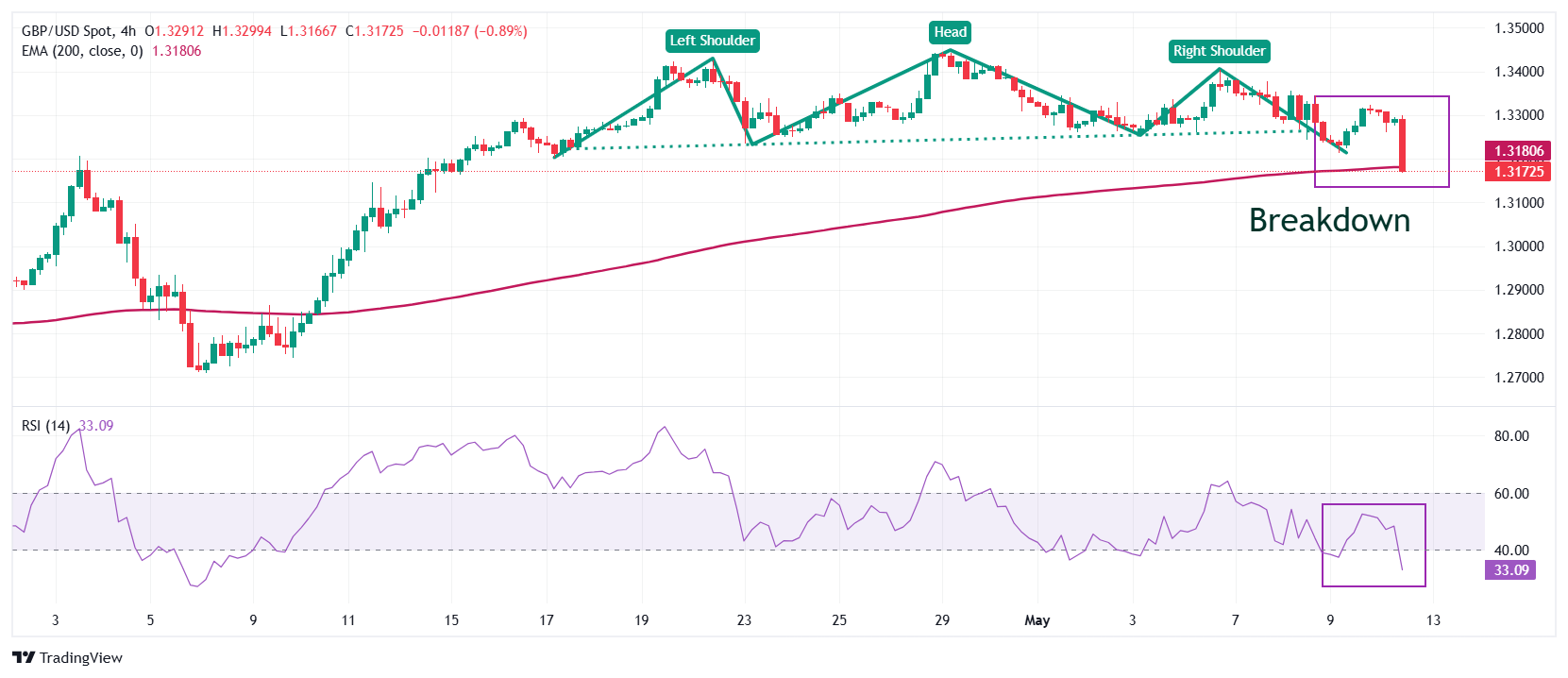
The Pound Sterling slips below 1.3200 against the US Dollar at the start of the week. The pair’s outlook has turned bearish on a breakdown of the Head and Shoulders (H&S) formation on a four-hour timeframe. A breakdown of the H&S chart pattern leads to a bearish reversal, and its formation near a critical resistance increases its credibility.
The Cable slides to near the 200-period Exponential Moving Average (EMA), which is around 1.3190, suggesting a bearish trend.
The 14-period Relative Strength Index (RSI) declines below 40.00. Fresh bearish momentum would trigger if the RSI sustains below that level.
On the upside, the three-year high of 1.3445 will be a key hurdle for the pair. Looking down, the psychological level of 1.3000 will act as a major support area.
Economic Indicator
BoE Interest Rate Decision
The Bank of England (BoE) announces its interest rate decision at the end of its eight scheduled meetings per year. If the BoE is hawkish about the inflationary outlook of the economy and raises interest rates it is usually bullish for the Pound Sterling (GBP). Likewise, if the BoE adopts a dovish view on the UK economy and keeps interest rates unchanged, or cuts them, it is seen as bearish for GBP.
Last release:
Thu May 08, 2025 11:02
Frequency:
Irregular
Actual:
4.25%
Consensus:
4.25%
Previous:
4.5%
Source:
Bank of England

